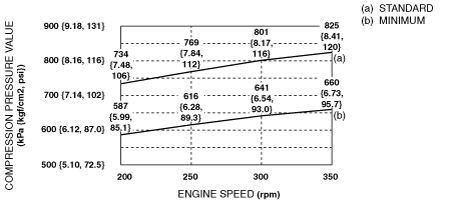COMPRESSION INSPECTION [SKYACTIV-G 1.5, SKYACTIV-G 2.0]
id0110h8800300
-
Warning
-
• Hot engines and oil can cause severe burns. Be careful not to burn yourself during removal/installation of each component.
• Fuel vapor is hazardous. It can very easily ignite, causing serious injury and damage. Always keep sparks and flames away from fuel.
• Highly pressurized fuel may spray out if the fuel line is cut.
Due to the following dangers occurring with a fuel spray, always complete the “Fuel Line Safety Procedure” to prevent the fuel from spraying.
-
― Fuel may cause irritation if it comes in contact with skin and eyes.
― If fuel ignites and causes a fire, it may lead to serious injury or death, and damage to property and facilities.
1. Verify that the battery is fully charged. (See BATTERY INSPECTION.)
-
2. Connect the M-MDS to the DLC-2.
3. Warm up the engine to the normal operating temperature.
4. Display the following PIDs using the M-MDS data monitor function. (See PCM INSPECTION [SKYACTIV-G 1.5, SKYACTIV-G 2.0].)
-
• RPM (engine speed)
5. Perform “Fuel Line Safety Procedures”. (See BEFORE SERVICE PRECAUTION [SKYACTIV-G 1.5, SKYACTIV-G 2.0].)
6. Remove the following parts:
- (1) Seal cover (See SEAL COVER REMOVAL/INSTALLATION [SKYACTIV-G 1.5, SKYACTIV-G 2.0].)
- (2) Fuel pump relay
- (3) Fuel injector relay
- (4) Ignition coil/ion sensors (See IGNITION COIL/ION SENSOR REMOVAL/INSTALLATION [SKYACTIV-G 1.5, SKYACTIV-G 2.0].)
- (5) Spark plugs (See SPARK PLUG REMOVAL/INSTALLATION [SKYACTIV-G 1.5, SKYACTIV-G 2.0].)
7. Measure the compression pressure using the following procedure.
- (1) Install the compression gauge to the spark plug hole.
- (2) Fully depress the accelerator pedal.
-
-
Note
-
• The cranking method is as follows.
MT
-
― When the ignition switch is pressed with the clutch pedal depressed, cranking starts.
― When your foot is removed from the clutch pedal during cranking, cranking stops.
― When the ignition switch is pressed during cranking, cranking stops.
AT
-
― When the ignition switch is pressed with the brake pedal depressed, cranking starts.
― When the ignition switch is pressed during cranking, cranking stops.
- (3) Crank the engine and measure the following values simultaneously.
-
-
• Compression pressure
• Engine speed
-
Compression pressure [SKYACTIV-G 1.5]
-
Standard: Refer to the graph.
Minimum: Refer to the graph.
Maximum difference between cylinders: 131 kPa {1.34 kgf/cm2, 19.0 psi} [250 rpm]
-
Compression pressure [SKYACTIV-G 2.0]
-
Standard: Refer to the graph.
Minimum: Refer to the graph.
Maximum difference between cylinders: 148 kPa {1.51 kgf/cm2, 21.5 psi} [250 rpm]
- (4) Perform Steps (1) to (3) for all cylinders.
- (5) If a measurement is less than the minimum specification, or there is a cylinder which exceeds the specified difference between cylinders, add a small quantity of engine oil through the spark plug hole and perform Steps (1) to (3).
-
-
• If the pressure increases by adding the engine oil, the piston ring or the cylinder surface is worn, or they are damaged. Perform overhaul servicing.
-
• If the pressure does not increase, valve seizure, valve attachment malfunction, or pressure leakage from the cylinder head gasket might be occurring. Perform overhaul servicing.
- (6) If the measured value is high, it is possible that there is an error in the electric variable valve timing system.
8. Remove the compression gauge.
9. Install the following parts:
- (1) Spark plugs (See SPARK PLUG REMOVAL/INSTALLATION [SKYACTIV-G 1.5, SKYACTIV-G 2.0].)
- (2) Ignition coil/ion sensors (See IGNITION COIL/ION SENSOR REMOVAL/INSTALLATION [SKYACTIV-G 1.5, SKYACTIV-G 2.0].)
- (3) Fuel injector relay
- (4) Fuel pump relay
- (5) Seal cover (See SEAL COVER REMOVAL/INSTALLATION [SKYACTIV-G 1.5, SKYACTIV-G 2.0].)
 amxzzw00003922Standard: Refer to the graph.Minimum: Refer to the graph.Maximum difference between cylinders: 131 kPa {1.34 kgf/cm2, 19.0 psi} [250 rpm]
amxzzw00003922Standard: Refer to the graph.Minimum: Refer to the graph.Maximum difference between cylinders: 131 kPa {1.34 kgf/cm2, 19.0 psi} [250 rpm] amxzzw00003923Standard: Refer to the graph.Minimum: Refer to the graph.Maximum difference between cylinders: 148 kPa {1.51 kgf/cm2, 21.5 psi} [250 rpm]
amxzzw00003923Standard: Refer to the graph.Minimum: Refer to the graph.Maximum difference between cylinders: 148 kPa {1.51 kgf/cm2, 21.5 psi} [250 rpm]